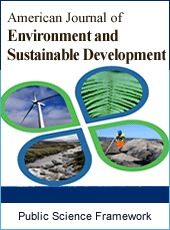American Journal of Environment and Sustainable Development
Articles Information
American Journal of Environment and Sustainable Development, Vol.1, No.1, Dec. 2016, Pub. Date: Aug. 19, 2016
The Structural Integrity of Concrete Quarry Dust Blocks (CQDB) Manufactured in Matsapha, Swaziland
Pages: 6-10 Views: 4570 Downloads: 1471
[01]
Bruce Roy Thulane Vilane, Department of Agricultural and Biosystems Engineering, Faculty of Agriculture, University of Swaziland, Luyengo Campus, Swaziland.
[02]
Thandeka Lucia Dlamini, Department of Agricultural and Biosystems Engineering Student, Faculty of Agriculture, University of Swaziland, Luyengo Campus, Swaziland.
Concrete quarry dust blocks (CQDB) are manufactured from a mixture of cement: sand: quarry dust. A descriptive study using structured questionnaires and Laboratory test procedures was conducted to determine the structural integrity of CQDB in Matsapha, Swaziland. The companies; [CM concrete (CM), Nkwality Bricks and Pavers (N), Roots (R), Dlamini Block Yard (D), Santos Block Yard (S) and Toepfer and Sons (T and S)] that used quarry dust to produce concrete blocks were studied. Five load bearing CQDB were purchased from each company. A thin film of plaster of Paris was applied prior to load testing using a compression load testing machine at a rate of 100 kN per minute. The results reflected that CM concrete, N, D, Roots, Toepfer and Sons as well as Santos produced CQDB with compressive strengths of 5.55 N/mm2, 3.39 N/mm2, 1.68 N/mm2, 1.24 N/mm2, 3.02 N/mm2, and 1.92 N/mm2, respectively. Only CM concrete manufactured CQDB that met the standard 4.0 N/mm2 mean compressive strength of 5 units. The CQDB manufactured by the other five companies were even below the standard 3.0 N/mm2 unit block compressive strength. The CQDB were fabricated using the mixtures; 1:2:3, 1:1:4, and 1:3:2. The mix 1:2:3 was used by CM concrete, D and N. Roots, T and S, used the mix 1:1:4 and S used the 1:3:2 mix. All the CQDB companies in Matsapha used the curing period of 7 days except for D and R which used curing periods of 3 and 4 days, respectively. It was concluded that the structural integrity of the CQDB manufactured in Matsapha was not of acceptable quality. This was evident from the compressive strengths attained by the CQDB manufactured. CM concrete was the only company in Matsapha that manufactured CQDB that met the 4.0 N/mm2 mean compressive strength of five (5) concrete block units enshrined in the South African National Standards (SANS 1215).
Structural Integrity, Quarry Dust, Concrete Blocks, Matsapha, Swaziland
[01]
Ambarish, K.; Manjunath, S.; Renukadevi, M. V.; and Jagadish, K. S. (2011). Effect of granite fines on strength of hollow concrete blocks. International Journal of Advanced Engineering Technology, 2(4): 475-479.
[02]
Anzar, H. M. (2015). Improved concrete properties using quarry dust as replacement for natural. International Journal of Engineering Research and Development, 2278-067. Accessed May, 2016. http://www.ijerd.com/paper/vol11-issue3/Version_1/E1134652.pdf.
[03]
Balamurugan, G. and Perumal, P. (2013). Use of quarry dust to replace sand in concrete; an experimental study. International Journal of Scientific and Research Publications, Volume 3, 12. Accessed May, 2016. http://www.ijsrp.org/research-paper-1213/ijsrp-p2412.pdf.
[04]
Khamphut, P. (2006). A Study of Compressive Strength of Concrete used Quarry Dust to Replace Sand. Technology and Innovation for Sustainable Development Conference Journal, 12: 108-110.
[05]
Koganti, S. P. and Chappidi, H. R. (2016). Geotechnical properties of quarry dust. EJGE (21) 2963 – 2973. Accessed June, 2016. http://www.ejge.com/2016/Ppr2016.0278ma.pdf.
[06]
Krishnamoorthy, A. and Aswini, R. (2015). Strength and corrosion resistance properties of Ggbs concrete containing quarry dust as fine aggregate. International Journal of Structural and Civil Engineering Research Vol. 4, No. 2. Accessed April, 2016. http://www.ijscer.com/uploadfile/2015/0922/20150922013944347.pdf.
[07]
Lohani, T. K.; Padhi, M.; Dash, K. P.; and Jena, S. (2012). Optimum utilization of quarry dust as partial replacement of sand in concrete. International Journal of Applied Sciences and Engineering Research, 1(2): 391-404.
[08]
Madhavi, E.; Vengal, A.; Rao, A.; Shekar, C. and Prabhaker, M. (2016). Experimental study of coarse aggregates and fine aggregates replaced by ceramic waste and quarry dust. International Journal of Innovative Research in Science, Engineering and Technology (IJIRSET). 2319-8753. Accessed May, 2016. http://www.ijirset.com/upload/2016/april/8_Experimental.pdf.
[09]
Rai, B.; Kumar, S. and Kumar, S. (2014). The effect of fly ash on mortar mixes with quarry dust as fine aggregate Advances in Materials Science and Engineering.
[10]
Raman, S. N.; Safiuddin, M. D. and Zain, M. F. M. (2007). Non-destructive evaluation of flowing concretes incorporating quarry waste. Asian Journal of Civil Engineering (Building and Housing), 8(6): 597-613.
[11]
Sachin, B. K.; Amol, J. M. and Vijayshree, A. A. (2012). Strength of concrete containing different types of fine aggregate. International Journal of Scientific & Engineering Research, 3(9): 1-3.
[12]
Sivakumar, A. and Prakash, M (2011). Characteristic studies on the mechanical properties of quarry dust addition in conventional concrete Journal of Civil Engineering and Construction Technology 2(10), pp. 218-235. Accessed April, 2016. http://www.academicjournals.org/journal/JCECT/article-full-text-pdf/A46776C3125.
[13]
SANS1215. (2008). Concrete masonry units. Standards South Africa. Pretoria, South Africa: South African National Standard (SANS).
[14]
Sivakumar, A. and Prakash, M. (2011). Characteristic studies on the mechanical properties of quarry dust addition in conventional concrete. Journal of Civil Engineering and Construction Technology, 2 (10): 218-235.
[15]
Osuji, S. O. and Egbon, B. N. (2015). Optimizing compressive strength characteristics of hollow building blocks from granite quarry dust and sand. Nigerian Journal of Technology (NIJOTECH) 34 (3) 478–483.
[16]
Ukpata, J. O.; Ephraim, M. E.; and Akeke, G. A. (2012). Compressive strength of concrete using lateritic sand and quarry dust as fine aggregate. ARPN Journal of Engineering and Applied Sciences, 7(1): 81-9.

ISSN Print: Pending
ISSN Online: Pending
Current Issue:
Vol. 6, Issue 4, December Submit a Manuscript Join Editorial Board Join Reviewer Team
ISSN Online: Pending
Current Issue:
Vol. 6, Issue 4, December Submit a Manuscript Join Editorial Board Join Reviewer Team
| About This Journal |
| All Issues |
| Open Access |
| Indexing |
| Payment Information |
| Author Guidelines |
| Review Process |
| Publication Ethics |
| Editorial Board |
| Peer Reviewers |


